Ramcharitmanas
| Ramcharitmanas | |
|---|---|
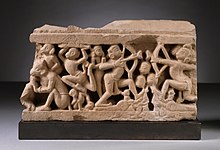
An architectural panel depicting scenes from the Ramcharitmanas, Hanuman Carrying the Mountain of Medicinal Herbs (left);
Rama Battles Ravana (right).
|
|
| Information | |
| Religion | Hinduism |
| Author | Tulsidas |
| Language | Awadhi |
| Verses | 10,902 |
Ramcharitmanas (Devanāgarī: श्रीरामचरितमानस, IAST: ŚrīRāmacaritamānasa), is an epic poem in the Awadhi language, composed by the 16th-century Indian bhakti poet Goswami Tulsidas (c. 1532–1623). The word Ramcharitmanas literally means "Lake of the deeds of Rama". [1] It is considered one of the greatest works of Awadhi literature. The work has variously been acclaimed as "the living sum of Indian culture", "the tallest tree in the magic garden of medieval Indian poetry", "the greatest book of all devotional literature" and "the best and most trustworthy guide to the popular living faith of the Indian people". [2]
| Part of a series on |
| Hindu scriptures and texts |
|---|

|
|
Puranas
|
|
Itihasa
|
| Related Hindu texts |
|
Sutras
|
|
Timeline
|
Tulsidas (the Sanskrit name of Tulsidas can be transliterated in two ways. Using the IAST transliteration scheme, the name is written as Tulasīdāsa, as pronounced in Sanskrit. Using the Hunterian transliteration scheme, it is written as Tulsidas or Tulsīdās, as pronounced in Hindi). Tulsidas was a great scholar of Sanskrit. However, he wanted the story of Rama to be accessible to the general public, as many Apabhramsa languages had evolved from Sanskrit and at that time few people could understand Sanskrit. In order to make the story of Rama as accessible to the layman as to the scholar, Tulsidas chose to write in Awadhi which was the language of general parlance in large parts of north India at the time. Tradition has it that Tulsidas had to face a lot of criticism from the Sanskrit scholars of Varanasi for being a bhasha (vernacular) poet. However, Tulsidas remained steadfast in his resolve to simplify the knowledge contained in the Vedas, the Upanishads and the Puranas to the common people. Subsequently, his work was accepted by all.
Ramcharitmanas, made available the story of Rama to the common man to sing, meditate and perform on. The writing of Ramcharitmanas also heralded many a cultural tradition, most significantly that of the tradition of Ramlila, the dramatic enactment of the text. [3] Ramcharitmanas is considered by many as a work belonging to the Saguna school [4] [5] of the Bhakti movement [6] [7] [n 1] in Hindi literature.
Background
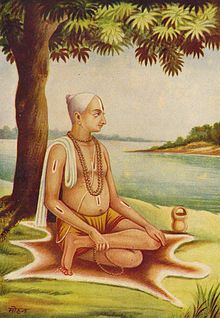 Picture of author, Tulsidas published in the Ramcharitmanas, 1949.
Picture of author, Tulsidas published in the Ramcharitmanas, 1949.
Tulsidas began writing the Ramcharitmanas in Ayodhya in Vikram Samvat 1631 (1574 CE). [n 2] [13] The exact date is stated within the poem as being the ninth day of the month of Chaitra, which is the birthday of Rama, Rama Navami. [13] Ramcharitmanas was composed at Ayodhya, Varanasi & Chitrakoot. [14] India was under the reign of Mughal emperor Akbar (1556-1605 CE) during this period. This also makes Tulsidas a contemporary of William Shakespeare. [n 3] [n 4]
The Ramcharitmanas is written in vernacular Awadhi language, [19] [20] [21] The core of the work is considered by some to be a poetic retelling of the events of the Sanskrit epic Ramayana [1] [22] [23] [24] [25] by Valmiki. The Valmiki Ramayana is centered on the narrative of Rama, the scion of the family tree of king Raghu of the Sun Dynasty. Rama was the crown prince of Ayodhya and is considered in Hindu tradition as the seventh Avatar of Vishnu. However, the Ramacharitmanas is by no means a word-to-word copy of the Valmiki Ramayana nor an abridged re-telling of the latter. Ramcaritmanas has elements from many other Ramayanas written earlier in Sanskrit and other Indian dialects as well as stories from Puranas. Tulsidas himself never writes Ramcharitmanas as being a retelling of Valmiki Ramayana. He calls the epic Ramcharitmanas as the story of Rama, that was stored in the mind (Mānasa) of Shiva before he narrated the same to His wife Parvati. Tulsidas claims to have received the story through his guru, Narharidas.Tulsidas was a naive (Acheta) child and the story was stored in his mind (Mānasa) for long before he wrote it down as Ramcharitmanas. Some understand this passage of the Ramcharitmanas to mean that Tulsidas at first could not grasp the story fully as he was a naïve young boy. His guru graciously repeated it again and again so that he could understand and remember it. Then he narrated the story and named it Ramcharitmanas as Shiva himself called it. The epic poem is, therefore, also referred to as Tulsikrit Ramayana (literally, The Ramayana composed by Tulsidas). [26]
The Ramcharitmanas is a masterpiece of vernacular literature. Some believe it to represent a challenge to the dominance of high-class Brahmanical Sanskrit, [27] [28] [29] echoing the revolt of Buddha against Brahmanical elitism. [30] However, this interpretation appears faulty as Tulsidas himself was a brahmin and often talks very highly of the Brahmins in Ramcharitmanas and other books written by him. It was the attempt of Tulsidas to reconcile the different stories of Rama and to bring the story within the reach of the common man.
Structure
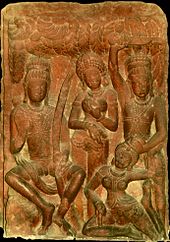 Scene Ramayana, Gupta art
Scene Ramayana, Gupta art
Ramcharitmanas consists of seven Kānds (literally "books" or "episodes", cognate with cantos). Tulsidas compared the seven Kāndas of the epic to seven steps leading into the holy waters of Lake Manasarovar "which purifies the body and the soul at once". [31] [32]
The first two parts, Bāl Kāṇḍ (Childhood Episode) and Ayodhyā Kāṇḍ (Ayodhya Episode), make up more than half of the work. The other parts are Araṇya Kāṇḍ (Forest Episode), Kiśkindhā Kāṇḍ (Kishkindha Episode), Sundar Kāṇḍ (Pleasant Episode), Laṅkā Kāṇḍ (Lanka Episode), and Uttar Kāṇḍ (Later Episode). The work is primarily composed in the Chaupai metre (four-line quatrains), separated by the Doha metre (two-line couplets), with occasional Soratha and various Chhand metres. [33]
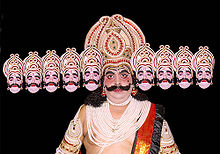 A Ramlila actor playing Ravana in traditional attire.
A Ramlila actor playing Ravana in traditional attire.
Invocations At Beginning of Each Episode
Every chapter of the Ramcharitmanas begins with an invocation or Mangalācharaņ. It is customary of the Indian tradition of writing that the author begins a new book with invocation to the Gods to ensure that the sankalpa is finished unhindered. The first three or four verses of each Kānd are typically in the form of invocations.
Bāl Kāṇḍ begins with a hymn honouring the goddess Saraswati and the god Ganesha, the deities related to knowledge, wisdom, speech and auspiciousness. [34]
Ayodhyā Kāṇḍ begins with the famous verse dedicated to the god Shiva: May He in whose lap shines forth the Daughter of the mountain king, who carries the celestial stream on His head, on whose brow rests the crescent moon, whose throat holds poison and whose breast is support of a huge serpent, and who is adorned by the ashes on His body, may that chief of gods, the Lord of all, the Destroyer of the universe, the omnipresent Śhiva, the moon-like Śańkara, ever protect me." [34]
Araṇya Kāṇḍ's first verse again extols Shiva: I reverence Bhagavan Śańkara, the progeny of Brahmā, the very root of the tree of piety, the beloved, devotee of King Śri Rama, the full moon that brings joy to the ocean of wisdom, the sun that opens the lotus of dispassion, the wind that disperses the clouds of ignorance, who dispels the thick darkness of sin and eradicates the threefold agony and who wipes off all calumny and obloquy. [34]
Kiśkindhā Kāṇḍ commences with the following verse: Lovely as a jasmine and a blue lotus, of surpassing strength, repositories of wisdom, endowed with natural grace, excellent bowmen, hymned by the Vedas, and lovers of the cow and Brāhmaņas, who appeared in the form of mortal men through their own Māyā (deluding potency) as the two noble scions of Raghu, the armours of true dharma, friendly to all and journeying in quest for Sita, may they both grant us Devotion. [34]
Sundar Kāṇḍ begins with a hymn in the praise of Rama: I adore the Lord of the universe bearing the name of Rama, the chief of the Raghu's line and the crest-jewel of kings, the mine of compassion, the dispeller of all sins, appearing in human form through His Māyā (deluding potency), the greatest of all gods, knowable through Vedānta (the Upanishads), constantly worshiped by Brahmā (the Creator), Śhambhu (Śivā), and Śeşa (the serpent-god), the one who bestows of supreme peace in the form of final beatitude, placid, eternal, beyond the ordinary means of cognition, sinless and all-pervading. [34]
Laṅkā Kāṇḍ begins with this hymn: I adore Śri Rama, the supreme Deity, the object of worship even by Śivā (the destroyer of Kāma, the God of Love), the Dispeller of the fear of rebirth, the lion to quell the mad elephant in the form of Death, the Master of Yogīs, attainable through immediate knowledge, the storehouse of good qualities, unconquerable, attributeless, immutable, beyond the realm of Māyā, the Lord of celestials, intent on killing the evil-doers, the only protector of the Brāhmaņas, beautiful as a cloud laden with moisture, who has lotus like eyes and appeared in the form of an earthly king. [34]
Uttar Kāṇḍ begins with the following hymn: I unceasingly extol Śri Ramā, the praiseworthy lord of Jānakī (Sītā, Janakā's daughter and the wife of Rama), the chief of Raghu's line, possessed of a form greenish blue, the color of the neck of a peacock and adorned with an insignia of Brahmā pada, the lotus-foot, which testifies to His being the greatest of all gods-rich in splendour, clad in yellow robes, lotus-eyed, ever-propitious, holding a bow and arrow in His hands, riding an aerial car named Puşpakā, accompanied by a host of monkeys and waited upon by His own brother Lakşmaņa. [34]
Kānd endings
Tulsidas ends every chapter in a similar manner describing the ending in the Sanskrit language. [35]
Every Kānd is formally concluded by Goswami Tulsidas. The following is an example of the ending of Kiśkindhā Kāṇḍ:
Translation: "Thus ends the fourth descent into the Mānasa lake of Sri Rama's exploits, that eradicates all the impurities of the kali age." All the other Kāndas are concluded in the same way where the word caturthah is substituted, according to the Kānd being concluded.
Narrative
Ramcharitmanas is structured around three separate conversations. The conversations happen between Shiva and Parvati, Sages Bharadwaj and Yajnavalkya and finally Kakbhushundi and the king of birds, Garuda. Some scholars are of the opinion that there is also an underlying personal conversation between Tulsidas and Lord Rama all through the text of Ramcharitmanas. [36]
Bāl Kāṇḍ
The Child Episode
Tulsidas begins the story with an invocation to various deities, his guru and saints who have preceded him and those who will succeed him in the future. Homage is paid to Valmiki for bringing the Ramayana to the devotees of Rama. Next are introduced and praised the various characters of the epic beginning with the birthplace of Rama, the holy city of Ayodhya. Praises are bestowed on Dasharatha, the king of Ayodhya and Rama's father and his queens Kausalya, Kaikeyi and Sumitra. Tulsidas then praises King Janaka (the father-in-law of Rama), and his family. He goes on to praise the brothers of Rama - Bharata, Lakshman & Shatrughna and sings the glories of Hanuman, the constant companion to Rama, Sugriva, the monkey king and Jambavan, the leader of bears. Next, the characters of Sita and Rama are introduced.
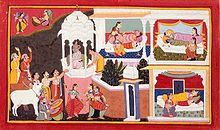 The birth of the four sons of Dasharatha.
The birth of the four sons of Dasharatha.
The story of Ramcharitmanas is then underway. It begins with the meeting of two sages - Bharadwaj and Yajnavalkya. Bharadwaj asks Yajnavalkya to narrate in detail the story of Rama. Yajnavalkya begins with how Shiva came about retelling the story of Rama to his wife Parvati. (The great story of Sati's self-immolation, the destruction of her father Daksha's sacrifice, the rebirth of Sati as Parvati and her marriage to Shiva). Shiva explains five different reasons as to why Rama incarnated on earth in different ages Kalpa (aeon). Each of these stories is discussed in detail, with the primary message being that Rama incarnated on earth to protect the righteous who follow the path of Dharma. The story then moves to the birth of Ravana and his brothers. Post this point, the narration is done at different times by Shiva, Yajnavalkya, Kakbhushundi and Tulsidas.
The story now moves to the abode of Brahma where Brahma and the other Hindu Devas are found mulling on the ways to rid the earth of Ravana and his excesses. Unable to find a solution, they pray to Shiva and ask him for his guidance on where to find the supreme God who will come to their rescue. Shiva tells them that they don't need to go anywhere to find the Supreme God for he resides in the hearts of his devotees. All the Devas then Pray to the supreme Brahman/Vishnu to rid the earth of the demons wreaking havoc on men as well as Devas. Brahman shows compassion to all and announces in an Akashvani that he will be born in the Sun Dynasty to save the Devas and His devotees from the demons.
The story then moves to Ayodhya. One fine day, Dasharatha, the king of Ayodhya, realizes that he has become old and still issueless. He conveys his distress to sage Vasistha, the family guru, and seeks the way forward. Vasistha comforts Dasharatha and tells him that he will have four sons. Vasistha requests Rishyasringa to perform the Putrakām yajna (vedic yajna for the birth of sons). Tulsidas states that the birth of Rama and his brothers took place on the ninth day of the Chaitra month. It was the fortnight of the moon, known as the shukla period.
The story then moves on and Rama and his brothers are now grown-up boys. The sage Vishvamitra arrives at Dasharatha's royal court where the King receives his eminent guest with great honour. Sage Vishvamitra lived in the forest and was performing great sacrifices. However, the demons Maricha and Subahu would always desecrate the ceremonial offerings. He knew that Rama had taken birth on earth to protect his devotees and so he decided to visit Dasharatha to ask him a favor. The sage asks the king to let his sons accompany him to the forest. Reluctantly the king agrees. Rama knew beforehand the intention of Vishvamitra in asking him to come along with him. He assures the sage that he would obey his commands. Lakshman kills Subahu and Rama kills Tataka and defeats Maricha, the dreaded demons.
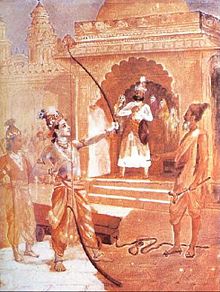 Vishvamitra looks as Ram breaks the bow, to win the hand of Sita in marriage.
Vishvamitra looks as Ram breaks the bow, to win the hand of Sita in marriage.
The story then moves to the deliverance of Ahalya. Rama, Lakshman and Vishvamitra venture on a journey and reach the beautiful kingdom of the Videhas, Mithila. The king of Mithila, Janaka, welcomes the great sage and asks him who are the two boys accompanying him. Janaka is overcome by great emotion as he is able to sense the true nature of their mission. The brothers then set out to discover the beautiful city and visit Janaka's garden. This is an important section of the manās as it portrays the first meeting of Rama and Sita.
In the meanwhile, King Janaka arranges a swayamvara ceremony for his daughter Sita. A swayamvara ceremony is a Vedic ritual in which a prospective bride selects her groom from among a group of suitors who attend the ceremony. Sita falls in love with Rama at first sight in Janaka's garden and prays to Parvati that she may get Rama as her husband. King Janaka sends a messenger to invite Rama, Laksman and Sage Vishvamitra to attend the swayamvara. Janaka puts a condition to identify the right groom for Sita. The great bow of Shiva by the name of Pinaka was kept in the arena. Any suitor who would be able to string Pinaka would be married to Sita. Many princes try but fail to even nudge the mammoth bow. This causes great distress to Janaka who wonders aloud if the earth has become devoid of brave men. This statement of Janaka angers Lakshman who retorts that no one talks in this vein, when a gathering like this, has the presence of scions of the Sun Dynasty. Rama gently nudges him to keep calm as Vishwamitra asks him to break the bow and make Janaka happy once again. Rama steps in and effortlessly lifts and strings the divine bow. In a swift move, he breaks the bow. The breaking of Pinaka causes a great noise that disturbs the great sage Parashurama in his meditation and he storms into the swayamvara arena in great anger vowing to kill whoever had dared to break the bow of lord Shiva. Lakshman enters into an argument with Parashurama, paying scant respect to the sage who was known for his bursts of anger and was known to slay whoever dared to oppose him. Ultimately, Rama brings him around. Parashurama comes to know the real nature of Lord Rama as the ultimate Brahman, pays his respects and leaves for the forests for meditation. Sita places the wreath of victory around the neck of Rama in accordance with the rules of the swayamvara and is thus wedded to him.
However, Sita being his beloved daughter, Janaka desires to conduct a grand marriage of Sita and Rama in accordance with both Vedic and laukik (traditional) customs. Janaka dispatches messengers to Ayodhya to inform Dasharatha and his family about the marriage of Rama and Sita and invites them for the formal consummation of marriage ceremony. Dasharatha starts with a great marriage procession, consisting of Rama's family, friends and well wishers in addition to Shiva, Brahma and all Devas who take up human form and depart for Mithila. Along with Rama-Sita, Bharat-Mandavi, Lakshman-Urmila and Shatrughna-Shrutakirti's marriages are also arranged.
After a grand wedding, the kind of which had never been witnessed in the universe, Rama and Sita return to Ayodhya where there was a great celebration and much rejoicing. [37]
Ayodha Kāṇḍ
The Ayodhya Episode
Ayodhya was described as being like a heaven on earth ever since Rama and Sita came back from Mithila. As King Dasharatha was getting old, he wanted to install his son Rama as Prince Regent. He decided to start the ceremonies for his coronation the very next day. The Devas however became very concerned at the prospect of Rama remaining in Ayodhya and not pursuing the wicked Ravana, and vanquishing him. Something had to happen if Rama was to embark on his mission to rid the world of Ravana. They approached Goddess Saraswati for help.
King Dasharatha has three wives. Queen Kaushalya is the principal queen and the mother of Rama. Queen Kaikeyi is the mother of Bharata and Queen Sumitra is the mother of Lakshman and Shatrughna. Saraswati decides to influence the mind of one of Queen Kaikeyi's maid servants named Manthara. Manthara's mind harbors evil intentions and she begins to talk to Queen Kaikeyi in harsh and conceited tones. She finds fault with Kaikeyi for being supportive of the king's plan of installing Rama, as Prince Regent when her own mind tells her that Bharata would clearly be a greater king. At that time Bharata is in Kaikeya country visiting his uncle and so he is unaware of what is happening in Ayodhya. Slowly Queen Kaikeyi's mind is poisoned. Manthara reminds Queen Kaikeyi of the two boons that the King had promised her. Kaikeyi enters the private room in the royal palace, where the King gives audience to his queens and awaits Dasharatha. Dasharatha is greatly alarmed and concerned that Kaikeyi is sitting in the sulking chamber, while the entire population of Ayodhya is greatly happy and eagerly anticipating the coronation of Rama. Queen Kaikeyi speaks harshly to Dasharatha, which surprises the king. She reminds him of the two boons he promised her and to his bewilderment, asks him to install her son Bharata as Prince Regent and send Rama into the forest for 14 years. Queen Kaikeyi is unmoved by Dasharatha's lamentations and finally the king emotionally breaks down. The king's assistant Sumantra sends for Rama with a request to meet his father.
Queen Kaikeyi speaks to Rama and explains to him the boons that she had asked of His father. Rama is actually the Supreme Personality of Godhead incarnated on earth, yet He accepts His stepmother's request and decides to leave the kingdom as it serves his purpose as well. The people of Ayodhya remonstrate against Queen Kaikeyi who firmly believes that she is doing the right thing. Rama attempts to dissuade Lakshman and Sita from joining him but is unable to do so. The scene becomes very emotional as Rama, Sita and Lakshman greet their mothers before finally going to Dashratha to take leave of him. Dasharatha attempts, in vain, to try to talk Sita out of joining Rama in the forest.
 Rama, Sita and Lakshman meeting Sage Bharadwaj at his ashram in Prayag.
Rama, Sita and Lakshman meeting Sage Bharadwaj at his ashram in Prayag.
The residents of Ayodhya can't spare the thought of being away from Rama and decide to join him in the forest. Rama, Sita, Lakshman and Sumantra go incognito and in the dead of the night leave the city and move into the forest . They leave for a place called Sringaverapur after which they meet Guha, the Nishad king. They arrive at Prayag, the holy city where the Rivers Ganges, Yamuna and Saraswati meet. Rama meets with the Sage Bharadwaj at his ashram. Rama is overwhelmed with the reception and love shown by the people inhabiting the banks of the Yamuna. Rama then meets Sage Valmiki, the author of the Ramayan at Chitrakoot dham. Valmiki recognises the true opulence of Rama and sings His praises. At this point Tulsidas takes great care to describe the beauty of the land of Chitrakoot with some inspiring poetry.
Rama asks Sumantra to return to Ayodhya which saddens Sumantra. He not only wants to stay with Rama, he is also afraid of going back only to face the anger and wrath of the citizens of Ayodhya. Rama persuades him to go back. On returning to Ayodhya, Sumantra meets Dasharatha, who asks him the whereabouts of Rama. The pain of separation from Rama is too much for Dasharatha who passes away crying Rama's name.
Sage Vashishtha knows that Rama will not return to the kingdom and so immediately sends an envoy to call Bharata and Shatrughna back to Ayodhya. Bharata learns of all that has happened and chastises his mother, Queen Kaikeyi. He is greatly pained and blames himself for Rama leaving Ayodhya. He accuses her of bringing ruin to the family. Shatrughna comes across Manthara and beats her in rage. They approach Queen Kaushalya and see her in a sorry state. Bharata begs for her forgiveness and loudly laments while the Queen attempts to pacify him. She asks him to carry out his duty and rule Ayodhya, but Bharata cannot bear the thought of sitting on the throne with his father dead and his brothers in exile in the forest. The cremation of King Dasharatha takes place. Bharata and Shatrughna decide to go into the forest and ask Rama to return to Ayodhya and take the throne. Many citizens as well as the royal family, who have been grieving ever since Rama had left them, decide to join the brothers.
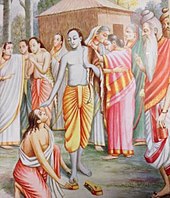 Bharata asks for Rama's paduka (footwear).
Bharata asks for Rama's paduka (footwear).
The Nishads see the approaching royal party and become suspicious. Guha approaches Bharata to understand his motive for bringing such a large party to the forest. He assumes that Bharata has some sinister motive. Bharata shows his love for Rama and Guha is moved to tears by his love for his brother. The royal procession then moves forward to Chitrakoot. Lakshman sees the huge army of people with Bharata and immediately begins to chastise Bharata. Rama counters this by praising the greatness of Bharata, leaving Lakshman feeling sorry for his harsh words. Bharata finally arrives at Chitrakoot where the brothers are all reunited once again. They collectively mourn the passing of their father and perform his Shraddha (obsequies) along with Sage Vashistha leading the ceremony.
Despite all of Bharata's convincing, Rama is true to the word given to his father and step mother Kaikeyi, and vows that he will fulfill her wish. Bharata says that he simply cannot sit on the throne while Rama wanders in the forest. He asks Rama for his sandals, which he would place at the throne and would only act as Rama's representative and not as a full-fledged king.
With much sorrow and hurt, Bharata leaves Rama and returns to Ayodhya. He decides that he would not live in the kingdom while Rama is in exile and so lives like a hermit in a nearby town called Nandigram. [38]
Araṇya Kāṇḍ
Main article: Araṇya-Kāṇḍa (The forest episode)
The Forest Episode
 Ravana fights Jatayu as he carries off the kidnapped Sita.
Ravana fights Jatayu as he carries off the kidnapped Sita.
Rama, Sita and Lakshman wander in the forest and come across the hermitage of a sage called Atri. Atri sees them approaching and is overcome with great joy. Sita is embraced by Atri's wife, Anasuya. Anusuya talks to Sita at length about the duties of a devoted wife.
Rama, Sita and Lakshman venture further into the forest and encounter Viradha. Viradha attempts to capture Sita. Rama kills him by burying him in a ditch. They then visit the ashram of Sage Sarabhanga. Rama asks him of where he should go for shelter in the forest. He is advised to visit the sage Sutiksna. As Rama approaches Sutiksna, the latter comes out of his meditation. He tells Rama that he had been awaiting his arrival and had even turned down the offer of entering the heavenly planets.
Thirteen years pass. Continuing on their journey through the forest, they meet with Sage Agastya where Rama pays his respect to the sage. Agastya gifts divine weapons to Rama and advises him to venture further into the forest and into the region of Dandaka. Rama meets with the eagle, Jatayu. Rama, Sita and Lakshman take up abode at Panchavati and build a beautiful ashram, as per the advice of Agastya. Lakshman becomes nostalgic of the past and begins to talk harshly about Kaikeyi. Rama pacifies him and explains that it is sinful to speak of his mother in such a way.
The story takes a new turn, as Rama, Sita and Lakshman are approached by the sister of the demon-king Ravana, called Surpanakha. She immediately takes a liking to Rama and falls in love with him. She disguises herself and talks to Rama in sweet tones. Rama rejects her advances explaining that he is already married and advises her to approach Laksman as he is unmarried. However, Laksman also rejects her advances. Surpanakha takes it as a great insult to be spurned like this, and attempts to hurt Sita. Laksman takes hold of his sword and lops off Surpanakha's ear lobes and nose. Feeling humiliated, Surpanakha leaves the forest and goes to the abode of her brothers Khara and Dusana. They are angry at the treatment meted out to their sister and leave with the intention of killing Rama. Both the brothers are vanquished by Rama.
Surpanakha is greatly upset and visits Ravana at his residence in Lanka. She explains all that has happened, after which Ravana calls for his old friend Maricha. Ravana hatches a plot and asks Maricha to disguise himself as a golden deer, so that Ravana may then kidnap Sita. Maricha has already felt the power of Rama (as mentioned in Bālakāṇḍa) and is apprehensive, however, he thinks that he is going to die either way since Ravana will kill him in rage for refusing him. Ravana and Marich immediately leave for Rama's forest abode.
Maricha takes his position and instantly Sita is attracted by his deer form. Rama knows that Ravana's intentions and orders Sita to place her shadow (Maya Sita) in her place, while she would hide in the fire. She asks Rama time and time again to hunt for the deer and bring it to her. Rama runs after the deer and is soon quite a far distance away from the ashram. Rama releases an arrow and hits the deer. Impersonating Rama's voice, Marich shouts out to Lakshman to help him. Maya Sita (hereafter called simply Sita) hears the cry and orders Laksman to go help his brother. Ravana, while posing as a begging minstrel, uses this opportunity to forcibly kidnap Sita from the ashram.
Jatayu, the eagle, sees Ravana's sinful act and attempts to fight with him, but Ravana has too much power and cuts off Jatayu's wings and leaves him for dead. Rama and Lakshman return to find the ashram empty. They anxiously set out to find Sita and find the severely wounded eagle. Jatayu dies in Rama's lap and receives liberation.
As they continue to look for Sita they come across the hermitage of Shabari. Tulsidas says that Shabari washes the feet of Ram with tears from her eyes and feeds him half eaten wild berries to ensure he gets only sweet ones. She is given liberation by Rama. The brothers then head towards the Pampasarovar lake. [39]
Kiśkindhā Kāṇḍ
The Kiśkindhā Region Episode
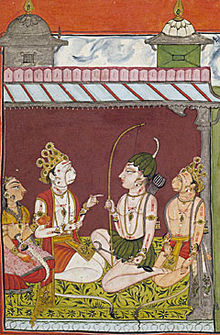 Lakshman meets with Tara, Sugriva and Hanuman in the Palace of Kishkandha
Lakshman meets with Tara, Sugriva and Hanuman in the Palace of Kishkandha
High up in the Rishyamukha mountains, Sugriva sees Rama and Laksman at the foothills. He consults Hanuman as to whether he thinks they have been sent by his brother Bali. Hanuman disguises himself as a Brahmin and approaches the brothers. Hanuman recognises the true nature of Rama as God-incarnation and surrenders himself to his Holy feet. He tells the brothers that his king, Sugriva, wishes to extend his friendship to them and will help them to find Sita. Rama asks Sugriva why he resides in the mountains instead of Kishkindha, where Sugriva tells of his feud with his brother Bali. Rama sympathises with Sugriva and decides to help Sugriva in return for the latter's help in finding Sita. Rama kills Bali and installs Sugriva as king of Kishkindha and Angada, Bali's son, as prince regent.
Sugriva becomes too attached to his new regal lifestyle and forgets about his agreement with Rama, which fills Rama with great anger. Rama asks Lakshman to bring Sugriva to him. Lakshman enters the royal court and threatens to burn the entire city to ashes. Sugriva is gravely worried and asks Hanuman to pacify him. Lakshman escorts Sugriva to Rama and upon seeing Him, Sugriva falls as his feet and begs forgiveness.
Sugriva immediately orders the gathering of the region's bear and monkey community. Armies of bears and monkeys are dispatched north, south east and west to search for Sita. Rama knew that only Hanuman was really capable of finding Sita. He asks Hanuman to narrate the agony of separation from her and then hands over his ring. Hanuman is joined by Angad, Nala, Nila, Kesari and Jambavan as well as many others as they head to the south. As the army approach the coast, Jambavan and Angad see a cave by the shore of the ocean. The cave is occupied by Sampati (who is actually Jatayu's older brother). There is a conversation during which Angad explains that Jatayu died serving Rama and thereafter Sampati narrates his biography. He tells the monkeys that he is sure that Sita is captive in Ashok Vatika in Lanka. The island is 400 miles away and requires someone who is able to jump the distance. Jambavan deduces that Hanuman is the only one capable of the task. [40]
Sundar Kāṇḍ
The Pleasant Episode
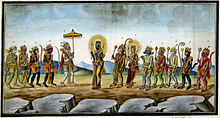 Rama and the monkey chiefs.
Rama and the monkey chiefs.
Hanuman takes Jambavan's suggestion and immediately takes off for Lanka. He climbs onto the mountain and using it as a pivot, launches himself into the air. He meets Surasa, the mother of serpents and passes her test. The ocean demoness tries to capture Hanuman, thinking of him as a bird. He quickly kills her and then lands on the shore of the ocean in Lanka. He sees beautiful lush gardens, groves, lakes and reservoirs. Hanuman takes a minute form and remembering Rama, enters Lanka. He is accosted by the demon Lankini whom he hits with his fist and causes her to fall to the ground. She recites that curse given to her would cure only when a huge monkey hits her and on the same day the starting of the end of Lankesh Ravan would be marked.
Hanuman flies through the various palaces and gardens for his search of Sita and amongst all the demonic activities going on in Lanka, Hanuman sees a palace where Shri Hari's name is being chanted. He is drawn towards the palace and decides to visit the inhabitant. The palace belongs to Ravana's brother, Vibhishan. Hanuman narrates Rama katha (story) and then introduces himself. Hanuman proceeds to Ashok Vatika where he finally sees Sita. He positions himself on a branch of a tree, under which Sita was sitting and contemplates his next move. He sees Ravana walk towards Sita and beg her to glance at least once toward him. She simply looks at a blade of grass to insult him. Ravana threatens to behead Sita but is calmed down by his wife, Mandodari. Hanuman has to use all his powers of calm not to react to Ravana's threats. When all is quiet again, Hanuman begins to sing the glory of Rama in sweet tones. He then approaches Sita and explains who he is. He presents the ring lord Rama had given him and Sita is overjoyed. She blesses Hanuman with many kind words and boons.
Hanuman tells Sita that he is hungry and asks for her permission to eat fruits from the grove. He not only eats but manages to destroy large parts of it. He easily kills one of Ravana's sons, prince Akshaya. Indrajit arrives in the grove and Hanuman allows himself to be captured. He is brought in front of the king of Lanka, Ravana. Ravana orders his death, however, Vibhishan reminds him that Hanuman is an envoy and cannot be killed according to religious principle. Ravana decides to humiliate Hanuman by setting his tail on fire. Large amounts of clothes are tied to his tail and soaked in oil. Hanuman chants the name of Rama and his tail begins to get longer and more cloth and oil is used. He changes from his small form into a gigantic form and decides to torch alight the whole of Lanka.
He returns to the ocean to extinguish his tail and then goes to Sita to reassure her that the next time she sees him, it will be with Rama. He bids farewell to Sita and leaps back towards Angad and Jambavan. The monkey army then ventures back to where Sugriva, Rama and Lakshman are waiting. On arrival, Hanuman explains all that happened and immediately an army is prepared to go south towards Lanka.
Meanwhile, in Lanka, both Mandodari and Vibhishan ask Ravana to hand Sita back to Rama. Ravana takes great exception to this suggestion and begins to insult Vibhishan particularly. He tells him he has no need for a weakling like him and that he is no longer needed. Vibhishan decides to join Rama at Kishkindha. Vibhishan falls at Ram's feet and asks him for protection.
The army deliberate over how to cross the ocean to Lanka. The deity of the seas tells Rama of the boon obtained by the monkey brothers Nila and Nala and that they have the power to build a bridge to link the seashore to Lanka. [41]
Lanka Kāṇḍ
The War Episode
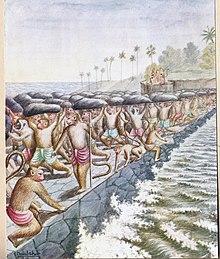 Building Rama Setu Bridge to Lanka.
Building Rama Setu Bridge to Lanka.
Jambavan asks the monkeys Nala and Nila to begin work on building the bridge across the sea. The Mānas states that entire mountain ranges were used by Nala and Nila to complete their objective. Rama remembers Lord Shiva and decides to install a shrine for Rameswaram. Upon completion, the army of Rama begins to cross the bridge and arrives at Lanka, taking camp on Mount Suvela. Ravana hears of the advances of Rama's army and feels greatly agitated. Mandodari asks Ravana to return Sita to Rama as she fears for her husband's life. Ravana is dismissive of Rama's power and pacifies his wife. Next, Ravana's son Prahasta attempts to reinforce his mother's sentiments, but all to no avail.
Rama fires a warning shot from his retreat in Suvela. The arrow strikes Ravana's crown and royal umbrella. Mandodari once again attempts to convince Ravana of handing Sita back to Rama. Meanwhile, Rama asks Jambavan what should be done. Jambavan suggests that they send Angada, as messenger, to give Ravana a chance to return Sita. On reaching Ravana's court, Angada explains he is the ambassador of Rama and tells Ravana that he still has time to save himself from destruction. Ravana insults Angada and his refusal to comply makes war inevitable.
The war begins with great ferocity as Ravana loses half of his army on the first day. Indrajit, Ravan's son, is required to enter the battle far earlier than he expected. He severely wounds Lakshman with his special weapon, the Saang. Hanumanji is ordered to fetch the doctor of Lanka called Sushena. Sushena tells Rama that there exists a herb called Sanjivani which can only be found in the Himalayan mountains. It is the only hope to save Lakshman. Hanuman immediately reassures Rama that he shall find this herb. As Hanuman is about to leave, Ravana orders the demon Kalanemi to impede him. However, Hanuman kills Kalanemi with ease. Hanuman reaches the mountain and can't find the herb. In his frustration he decides to take the entire mountain to Lanka.
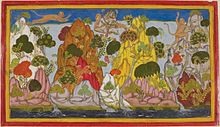 Hanuman searching for the Sanjivani herb.
Hanuman searching for the Sanjivani herb.
Hanuman makes good speed towards Lanka when suddenly he is shot by an arrow as he approaches Nandigram. Hanuman is mistaken to be a demon by Bharat. Hanuman falls to the ground together with the great hill. Hanuman regains consciousness and recognises that Bharata is Rama's brother. He continues on to Lanka where he delivers the Sanjivani herb and Sushena treats Lakshman. Rama embraces Hanuman with great pride and affection. Ravan takes the news of Lakshman's recovery very badly and decides to awaken his brother Kumbhakarna.
Kumbhakarna kills indiscriminately and wreaks much havoc. Rama releases an arrow which kills him instantly. The death of his brother scares Ravan greatly. Indrajit hastily tries to arrange a ceremony to receive great boons and powers but is interrupted by Hanuman and Angada. Lakshman takes up arms against Indrajit and kills him. Rama throws numerous arrows at Ravana but is unable to kill him. He asks Vibhishan on how to kill his brother after which Rama finally kills Ravana. The war is over.
Ravana's funeral takes place and Vibhishan is crowned the king of Lanka. Hanuman carries the happy news to Sita in Ashok Vatika. Finally Rama and Sita are reunited. Rama and the army prepare to depart Lanka and return towards Ayodhya. Rama, Sita, Lakshman and the senior monkeys travel back in Ravana's flying vehicle, Pushpak Vimaan. [42]
Uttar Kānd
The Epilogue
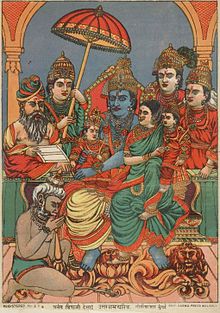 The Family of Rama
The Family of Rama
It is now the day before Rama is to return to Ayodhya after serving his exile. Bharata is anxious that his brother still hasn't arrived. The Mānas mentions that Bharata had passed his days shedding tears for fourteen years in Nandigram. Hanuman meets Bharata telling him of the arrival of Rama, Sita and Laksman. Bharata rushes to Ayodhya to tell the citizens of the great news. As the Pushpak Vimaan landed in Ayodhya the citizens shouted chants of 'Glory be to Ramchandra'. Rama, Sita and Laksman collectively touch the feet of the sage Vashishta on arriving in Ayodhya and thereafter greet all that have gathered in the assembly. Lastly Rama meets Bharata with great affection and love. Rama's coronation takes place and he is finally crowned king of Ayodhya. Shiva arrives to glorify the festivities further and asks Rama of the boon that he may have firm and undeviating devotion of Rama's feet.
In conclusion to the tale, Rama has twin sons named Lava and Kusha. The other brothers each have two sons as well. It is mentioned that great sages like Nārad and Sanaka visit Ayodhya to meet with Rama and to see his great city.
In the subsequent passages of Uttar Kānd the biography of Saint Kakbhushundi is given, followed by a description of what is to be expected in the current age of Kaliyuga. Shiva ends his narration of the Rama Katha to Parvati as does Kakbhushundi to Garuda. It is not mentioned whether Yajnavalkya finishes his recitation to Bharadwaj. Finally, Goswami Tulsidas concludes his retelling of the Shri Ramcharitmanas. [43] The Rudrastakam in Sanskrit is a part of this Kanda.
Stories Behind The Incarnation of Rama
During the Bālakāṇḍa, it is mentioned that Shiva is retelling the story of Rama (Rama Katha) to his spouse Parvati. During this retelling, Shiva explains as many as five reasons why Rama incarnated on earth.
Jay and Vijay
The brothers Jay and Vijay are the two favored gate keepers of Hari. Due to a curse, by the Brahmin Sanaka and his three brothers, Jay and Vijay were born in the species of the demons. One took the birth of Hiranyakashipu and the other was born as Hiranyaksha. The Supreme incarnated Himself as Varaha in order to kill Hiranyaksha, while incarnating as Narasimha to kill Hiranyakashipu. Even though these brothers are killed by Hari Himself, they do not attain liberation as the Brahman's had cursed them to three births and so were reborn as the powerful demons Ravana and Kumbhakarna. Hari took a human incarnation, as Rama, to kill Ravana and Kumbhakarna. [44] [45]
The Curse of Nārad Muni
Nārad Muni was wandering in Himalayan mountains and begins to think about Vishnu. He instantly falls into a deep meditative trance. Seeing the sage's state, Indra becomes apprehensive as he sees Nārad's trance as a threat to his own position as the chief of demigods in heaven. Indra asks Kamadeva to disturb Nārad's trance. He creates an illusion of fragrant flowers, delightful breezes and such. Heavenly damsels are called but all this has no effect on the sage. Kamadeva accepts defeat and falls at Nārad's feet, addressing him with deep humility. He recalls all that happened to Shiva and becomes puffed up with pride of his defeating of Kamadeva. Shiva admonishes him not to repeat the story to Hari.
Nārad visits Vishnu at his abode and unable to control his pride, re-tells his episode with Kamadeva, ignoring all that Shiva had advised. Vishnu further fans Nārad's pride by telling him that his steadfast vow of celibacy is so strong that he can never be smitten. Nārad then departs Vishnu's abode. Hari tells Laksmi that he has a plan and sets his illusory powers (maya) into operation. As Nārad departs Vaikuntha, Vishnu creates a beautiful illusory city with illusionary inhabitants. The city is ruled by King Sheelanidhi, who has a beautiful daughter called Vishvamohini. Nārad is intrigued with the city and decides to visit the king. Nārad sees the king's daughter and falls in love with her. The king explains that he wishes to marry his daughter to a suitable man. Nārad devises a plot to get the princess to choose him.
Nārad approaches Hari and asks him for the gift of great beauty. Vishnu says that he will do only that which is beneficial to Nārad. The sage is glad at heart and thinks that with Vishnu's favor, the princess will surely choose him. Narad desired the appearance of Lord Vishnu. He asked Lord to give him "Hari mukh", which translates into "Face of Hari ". Hari word has many meanings, Lord Vishnu, monkey, frog, snake etc. Lord granted his wish by giving him Face of a monkey. The entire royal court is aware of Nārad's appearance, but says nothing. The princess filled with rage as soon as she sees Nārad's ugly form and completely ignores him. He sees a reflection of his face in water and is consumed with rage. He instantly goes back to Vaikuntha and begins to speak to Hari in ugly tones. He curses Hari, "You made me look like a monkey; therefore You shall have monkeys for Your mates. And as You have grievously wronged me, so shall You suffer the pangs of separation from Your wife". Hari accepts Nārad's curse and instantly withdraws his illusionary spell.
Nārad realises that there is no city and there is no Visvamohini, and is dismayed at what he has done. He begs Vishnu to invalidate his curse. Hari explains that it was His will and advises Nārad to chant his name to absolve himself of any sin. Nārad returns to his abode chanting the praises of Ram. [46]
Svayambhuva Manu & Shatarupa
Svayambhuva Manu had Shatarupa as his wife. Manu ruled the earth for many years and carried out the Lord's commandments. He longed to devotion to Hari and decides to give up ruler ship to his son so that he can retire to the forest with Satarupa and meditate upon the Lord. Manu and Satarupa settle at the banks of the Sarayu river and devoutly repeat the twelve-syllable Mantra, calling out to who is the source of many Brahmas, Vishnus and Shivas emanate. [47] Some commentators indicate that the twelve-syllable mantra is the Vishnu mantra (Oṃ Namo Bhagavate Vāsudevāya). [48] Rambhadracharya comments that the twelve-letter mantra is the coupled mantra for Sita and Rama. [49]
Manu and Shatarupa first sacrifice food and then water and are finally willing to sacrifice air. Brahma, Hari and Shiva call on Manu but Manu and Satarupa are resolute and do not swerve on their sacrifices. A great voice from the heavens tells Manu, in sweet tones, to ask for a boon. Rama and Sita approach Manu in a beautiful form, [50] which leaves Manu overcome with emotion. Manu explains now that he and Satarupa have seen the Lord's lotus feet, all their desires have been met. Manu has one longing but doesn't know how to ask the Lord. Finally he asks, "O gracious Lord, I tell You my sincere wish: I would have a son like You. I have nothing to conceal from You."
The Lord announces that it shall be, however, where would he find a son like Himself? The Lord tells Manu that He Himself would be a son to him. The Lord then asks Satarupa of her wish. She says that she greatly likes the boon received by her husband and wants the same. Bowing at the Lord's feet, Manu then asks one more favour. He asks that he be dependent on which is granted. The Lord then commands the couple to dwell in Indra's capital in heaven.
The Lord explains that after some time Manu would be born as the king of Ayodhya, Dasharatha and Satarupa as Kausalya. He would then manifest Himself in the royal household as their son. He reassured the couple that their desire would be accomplished. [51]
Tale of King Pratapbhanu
Prior to the birth of Rama, Muni Bharadwaja is told the story of King Pratapbhanu by Yajnavalkya. There is a kingdom called Kaikay where Satyaketu is king. He has two sons, Pratapbhanu and Arimardana and rules his kingdom with his prime minister Dharamaruchi. Satyaketu abdicates and hands the reign to Pratapbhanu, who becomes conqueror of the world.
Once Pratapbhanu goes into the forest to hunt and sees a wild boar. The boar is actually the demon Kalaketu in disguise who runs away from the king. Pratapbhanu gives chase deeper into the forest. Pratapbhanu chases for many miles and becomes thirsty. He approaches a fake saint's ashram, where the resident fake saint wants to hurt and insult Pratapbhanu due to a previous incident. Pratapbhanu doesn't recognize the saint, who begins to sweet talk the king and says that by pure love, he wishes to impart boons onto the king. The king asks to be invincible and never ageing, which the fake saint grants, but with the condition that he needs to win favor of all Brahmans. The fake saint advises that the king arrange the cooking of holy food (prasadam) to feed the bramanas, who would surely be in his favor for such an act of kindness. The fake saint's real intention is to trap the king and repay him for his old grievances.
The fake saint asks the king to go rest, and that he would arrange the feast for the bramanas using his mystic powers. Pratapbhanu waits for three days for the fake saint. Kalaketu, now disguised as a priest, approaches the King in his court and says that he has been sent to cook the holy food. The entire brahmana community is invited. A heavenly voice from above warns the brahmanas that the food is impure and they should run away immediately. They curse the king that he, his kingdom and entire family are wiped from the face of earth. They also curse that he be born a demon in his next life. The heavenly voice says that the brahmana's curse is ill thought, as Pratapbhanu is not to blame. Since their curse cannot be taken back, the voice says that it is the Brahmana community that will bare the brunt of the evil of his next life.
Pratapbhanu is distraught and quickly goes to his kitchen to find Kalaketu. The king is pained and cries as he realizes Kalaketu has vanished. The brahmanas feel sorry for Pratapbhanu and tell him that his evil next life will be ended by Supreme Vishnu himself. As per the curse, Pratapbhanu, Arimardam and Dharmaruchi are all killed as other neighboring kings invade Kaikay.
Pratapbhanu is reborn as Ravan, Arimardam is reborn as Kumbhkarna and Dharmaruchi as Vibhishan. All three take great penances and are approached by Brahma and Shiva and are asked for any boon. Ravan asks that no one should be able to kill me except the tribes of man and monkeys. Kumbhkarna asks for uninterrupted sleep for periods of six months. Vibhishan asks for unshakable love for the feet of Vishnu. [52]
The Immolation of Sati & The Incarnation of Parvati
The story of how Shiva came about retelling Ramkatha to his consort Parvati is retold in great detail within the Bālakāṇḍa. This part of the story is narrated by Sant Yajnavalkya to Bharadvaj Muni.
Sati's doubts
In the age of Treta, Shiva, accompanied by His consort Bhavani Sati, went to visit Rishi Agastya. The Rishi being pleased with Shiva's visit, began to narrate the eternal story of Ram. Shiva listens with great pleasure and then they return towards Their abode. Around these exact days Ram had descended on earth and was wandering the Dandaka forest with Sita and Lakshman. Shiva ponders how he can catch sight of Ram. He finally sees Ram, who is frantically searching for Sita and instantly joins his palms and prays "Glory to the Redeemer of the universe, who is Truth, Consciousness and Bliss". Sati cannot recognize Ram and wonders why her Supreme Shiva is praising a mortal. Shiva is the knower of all truth and instantly reads Sati's thoughts. He advises her to not harbor such doubts and accept that she had seen Ram, whom Agastya had praised earlier. He finally says that if she is still not convinced then she should seek to verify this truth herself. Shiva observes as Sati takes the guise of Sita. Ram and Lakshman instantly see through Sati's disguised and asks about Shiva's whereabouts. Sati feels very uncomfortable and heads towards Shiva, thinking of how she is going to explain her folly of questioning His word.
Shiva asks her to tell the truth of how she tested Ram. Sati is unable to tell the truth and says that she did not test Ram, but praised his as You had. Sati forgets that Shiva knows all that has happened and is disappointed that she was disguised as his Sita. He decides that Sati is too chaste to abandon and it is a sin to continue to be her Husband and so from then he has no connection with Sati in her current body. Sati concludes that Shiva has come to know everything and feels very foolish for having tried deceiving Him. Shiva sits under a banyan tree and enters into a long trance. Sati feel extremely sorry but accepts that providence is repaying her for her sins. Many years pass and Shiva finally ends his trance whilst praising Ram. Sati bows down at Shiva's feet, after which he seats Sati opposite him and he begins to tell stories of Vishnu's exploits.
Daksha's Sacrifice
While Shiva is narrating the stories of Vishnu, the air is filled with celestial beings. Sati asks Shiva what the occasion is. Shiva explains that Her father Daksha has organised a great sacrifice where many demigods were invited. All except Brahma, Vishnu and Shiva were invited as Daksha had developed a hatred towards the Gods. Sati thinks of her father and asks if She may visit him at this time. Shiva says that they have no formal invite and that all of Sati's sisters are invited but because of his animosity towards Shiva, Her father has not invited us. Shiva tries to reason with Sati, that no good can come of Her attending, but Tulsidas explains that a daughters ties to her father are very strong.
When she reaches her father's abode, no one welcomes Her apart from Her mother. Daksha does not even acknowledge Her and actually burns with anger that She has turned up uninvited. Sati looks around and sees no oblations set apart for Shiva and the lack of respect of her father causes Her mind to rage with great anger. She faces Her father's court and announces that Shiva is the father of the universe and the beneficent of all. It is the same Shiva that Her father vilifies. She burns Her body with the fires of Yoga. Her guards are beaten and thrashed. When Shiva came to know this, he sends Virabhadra, who wreaks havoc of the sacrifice and Daksha is slain. As Sati is about to die, She asks Lord Hari of the boon that she be devoted to Shiva's feet in successive births. She is reborn as Parvati, the daughter of Himachal and Maina.
Parvati & Nārad's prophecy
Years after the birth of Parvati, Nārad Muni visits her parents Himachal and Maina. Himachal asks Nārad what the future holds for his daughter. Nārad says that Parvati will be adorned with good traits and win unfailing love of her husband. She will remain ever united with him and bring great glory upon her parents. The only drawback is that her husband will be an ascetic with matted hair who is naked and of hideous accouterments. Himachal and Maina become disconsolate while Parvati is greatly pleased, as she senses from Nārad's words that her boon from Vishnu is coming true. Nārad explains to Himachal that the only person who shows the virtues as described by him is Shiva. Parvati's parents are immediately uplifted and as Nārad leaves, he asks Parvati to fix Her thoughts on Hari and practice austerity. The young Parvati enters the forest and performs great penances in order to obtain Shiva. Her body thins greatly due to her self-mortification after which Brahma declares that she should cease her severe penances as Shiva would soon be hers. History had produced many great sages, but none had performed such penances as this. Brahma instructs that her father would soon come for her and that she should return home with him.
Ever since Sati had quit her body, Shiva had begun chanting Ram's name and entered into a great trance. Through his mystic power, Ram asks Shiva to marry Parvati. Shiva says that this is not a justifiable request but the word of a master cannot be set aside and must be obeyed. Shiva remains in his great trance. Around that time the demon Tāraka was causing distress and was in full flourish. Brahma declares that the son of Shiva will kill Tāraka, but for this to happen His wedding with Parvati needs to be arranged and for that to happen, Shiva's trance has to be broken. It is decided that the God of Love should be sent to awaken Shiva. He fires five arrows of flowers at Shiva's breast, the trance is broken and Shiva awakens. Shiva is enraged and, through his third eye, reduces Love to ashes. Love's consort Rati faints as soon as she hears of her husband's demise. Seeing the helpless woman, Shiva foretells that her husband will now be called bodiless and shall dominate all without a body form. When Krishna descends on earth, her husband would be born as His son Pradyumna. Thereafter Brahma and other gods approach Shiva and declare that they wish to witness His wedding with their own eyes. Remembering Vishnu's early request, Shiva gladly agrees and Brahma proceeds to arrange the marriage.
The wedding of Shiva & Parvati
Shiva has no real family and so his attendants begin to adorn Him for His wedding to Parvati. His hair is formed into a crown with serpents forming a crest. Serpents form His earrings, bracelets and adorn his neck and He is smeared in ashes and has lion's skin wrapped around His loins. He heads the wedding procession and Vishnu and Brahma, as well as a host of spirits, Gandharavs and Danavs follow behind. After the wedding, Parvati and Shiva return to Kailash where Parvati asks questions around Rama's divinity. Here Shiva begins his narration of Ram Leela.
The divinity of Ram in the Manas
Ram's divine birth
On the ninth day of the Chaitra month, the Manas describes that the Sun is at its meridian and the climate is neither cold nor hot. There is a cool, soft and fragrant breeze. The woods are full of blossom and the rivers are in full flow. Brahma deduces that the time for Ram's birth is approaching and the heavenly beings all crowd over the skies to glimpse sight of the auspicious moment. The sky resounds of music and songs as the heavenly beings offer their praises to the Supreme Personality of Godhead.
Here begins one of the most famous chhands from the Manas, the Ram Janam Stuti. [53] The stuti begins with the appearance of Ram. Mother Kaushalya's heart is filled with joy as she marvels over Ram's dark complexion and his four armed form. He is adorned with jewels and a garland of Sylvan flowers and is described as being an ocean of beauty. Kaushalya joins her palms and prays. "O Infinite, How can I praise You! The Vedas and Puranas reveal you to be the repository of all virtues. You are the Lord of Lakshmi and the lover of all of Your devotees and have appeared for my good. Every pore of Your body contains multitudes of universes and the thought that You stayed in my womb is truly staggering." Ram smiles and exhorts Kaushalya by telling her the charming account of her previous birth so that she can accept Him as her own child. Kaushalya asks Ram to give up His current superhuman form and to start to indulge in childish sports that are dear to a mother's heart. Ram, described as the Lord of immortals, immediately becomes an infant and begins to cry.
Tulsidas concludes that whoever sings this Stuti attains the abode of Lord Vishnu and never falls into the well of mundane existence. The Stuti has therefore been immortalized and it is a popular prayer sung on the occasion of Ram's birthday.
Deliverance of Ahalya
Ahalya, the wife of Rishi Gautam, was a beautiful woman. Indra, king of the gods, was tempted and decided to seduce her with trickery. Early morning Rishi Gautam when the dawn had arrived go down to the nearby Ganges for his usual morning bath. While the Rishi was bathing at the river, Indra assumed Gautam's form and visited Ahalya, fooling her into thinking he was her husband. When Gautam returned, he encountered Indra, emerging from his hut in his (Gautam's) form. Spiritually powerful, Gautam employed his divine vision to see the whole episode. Enraged, he cursed Indra with impotence. Losing his potency, Indra lost heaven to demons and sat prayerfully in a lotus flower for thousands of years in order to repent. Rishi Gautam, in a blind rage, also cursed his wife, Ahalya, to turn into a boulder. Innocent of any intentional wrongdoing, Ahalya begged for forgiveness. Gautam relented somewhat and said that when Ram is incarnated, he will bless her and break her curse.
Ram, while going to Mithila for Sita Svayamvar along with Sage Vishwamitra and Laksman, stopped at the, then-uninhabited, hermitage of Rishi Gautam. Vishwamitra narrated Ahalya's story to Ram, and asked him to free her. Ram touched the boulder with his foot and Ahalya was immediately released from the curse. She fell to Ram's feet and washed his feet with her tears. She felt that her curse had become her fortune as she got the opportunity to seek Ram's refuge in person. She then returned to her husband's place.
The Abrupt Ending
Many scholars have commented on the sudden ending to the Manas. Valmiki's Uttar Kānd goes into great detail about Sita going into the forest, as a result of disapproving gossip of the citizens of Ayodhya, during the rule of Ram over Ayodhya. Sitaji asks mother Earth to receive her and Ram leaves His human form and returns to His celestial abode. Tulsidas decides not to mention these at all. The Katha Kar Morari Bapu has mentioned in many of his retellings of Ram Katha, that Tulsidasji didn't want to end the Manas in heartache for Sita. Tulsidas refers to Sita as his mother (as well as the mother of the entire universe) many times in the poem and so, on an emotional level, this becomes very understandable. She has endured enough pain throughout the Manas and so ends his retelling at a relatively happy moment. It is said that there are some Vaishnav devotees who will only recite the Bālakāṇḍa of the Manas, as this is seen as the happiest period of Ram and Sita's leela on earth. [54]
English Translation
An unpublished English poetic translation of Ramcharitmanas is provided by (Late) Binda Prasad Khattri of New Market, Banda, Uttar Pradesh. Apparently, the translation can be sung essentially in the same way and with the same rhythm as the original Hindi work.
Frederick Growse translated the Ramcharitmanas into English under the title The Ramayan of Tulsidas during the nineteenth century. [55] His translation remains in print.
The English commentary by Morari Bapu, Mangal Ramayan, is an English composition of one of his orated Ram Katha commentaries. The book contains all the translations of prayers, Doha, Chaupais and Chandan sung by Bapu, as well as an in-depth discussion behind the meanings of the poetry.
See also
Notes and references
Notes
- Tulsidas, Kabir , Mirabai , and Surdas are considered the greatest devotional poets of Bhakti kāl [8] [9] [10]
- In verse 1.33.2 [11] of Bālkānd, the first chapter of Rāmcaritmanas, Tulsidas mentions 1631, Tuesday, as the date according to Vikram Samvat calendar, which is 1574 in Gregorian calendar or Common Era . [12]
- Pronounced as tool-see-DAHSS [15]
- Tulsidas was a contemporary of Akbar , Maharana Pratap , and William Shakespeare [3] [16] [17] [18]
References
- K.B. Jindal (1955), A history of Hindi literature , Kitab Mahal, " ... The book is popularly known as the Ramayana, but the poet himself called it the Ramcharitmanas or the 'Lake of the Deeds of Rama' ... the seven cantos of the book are like the seven steps to the lake ..."
- Lutgendorf 1991, p. 1.
- Subramanian 2008 , p. 19
- McLean 1998 , p. 121
- Puri & Das 2003 , p. 230
- Lele 1981 , p. 75
- Lorenzen 1995 , p. 160
- Lutgendorf 2006 , p. 92
- Sadarangani 2004 , p. 78
- Kumar 2001 , p. 161
- Tulsidas 1574 , p. 45
- Saraswati 2001 , p. 485
- O.P. Ralhan (1997), The Great Gurus of the Sikhs, Volume 1 , Anmol Publications Pvt Ltd, ISBN 978-81-7488-479-4 ,... It was on a Tuesday, the ninth day of Chaitra in the Samvat year 1631, that Tulsidas started writing the Ramcharitmanas in the city of Ayodhya on the banks of the sacred Saryu . The place and date are significant, Ayodhya being the birthplace and the day being the birthday of Sri Rama ...
- Rambhadracharya, Swami (2008). Ramcharitmanas Bhavarthbodhini Hindi Tika. Page No. xxxi
- Duiker 2012 , p. 3.1
- Singh 1990 , p. 121
- Mathew 2012 , p. H-39
- Ghosh 2002 , p. 104
- Lochtefeld 2002 , p. 713
- Coogan 2003 , p. 141
- Richman 2001 , p. 9
- Agarwal 2005 , p. 114
- MacFie 2004 , p. 115
- Bakker 2009 , p. 122
- Rajagopal 2001 , p. 99
- Lallan Prasad Vyas (1992), Ramayana, its universal appeal and global role , Har-Anand Publications, "... Its original name is Ram Charit Manas, but people call it Tulsi Krit Ramayan. (This has been the custom to name the Ramayan after its author). Tulsi Krit Ramayan was written in the 16th Century AD. This is the most popular and a work by a world renowned ..."
- Miller 2008 , p. 161
- Lamb 2002 , p. 39
- Ascher & Heffron 2010 , p. 27
- Mehta 1992 , p. 243
- Sanujit Ghose (2004), Legend of Ram: Antiquity to Janmabhumi Debate , Bibliophile South Asia, ISBN 978-81-85002-33-0 , "... Lake of the Deeds of Ram. He says that the seven cantos or sections of the work are like the beautiful flights of steps to the holy water of a lake, which purifies the body and the soul at once ..."
- Olive Classe (2000), Encyclopedia of literary translation into English: M-Z, Volume 2 , Taylor & Francis, ISBN 978-1-884964-36-7 , "... Rāmcāritmānas, composed in the Avadhi dialect of Hindi, is an epic of some 13,000 lines divided into seven kandas or 'books.' The word mānas (which Hindi speakers often use as an abbreviation of the longer title) alludes to a sacred lake in the Himalayas, and so the title may be rendered 'the divine lake of Ram's deeds' ..."
- Impact of Ramayan - http://www.bhuvaneshwarmandir.com/resources/impact.htm
- Shri Ramacharitamanasa, A Romanized Edition (1968 ed.). Gorakhpur: Gita Press.
- Gita press ShriRamcharitmanas - End of each Kānd of Gitapress version
- Morari Bapu 2000, pp. 58, 59, 134. https://openlibrary.org/b/OL2164668M/Mangal_Ramayan
- Bālakāṇḍa section of Gitapress version
- Ayodhya Kānd section of Gitapress version
- Aranya Kānd section of Gitapress version
- Kishkinha Kānd section of Gitapress version
- Sunder Kānd section of Gitapress version
- Lanka Kānd section of Gitapress version
- Uttar Kānd section of Gitapress version
- Jay and Vijay, the gatekeepers - http://www.srirangjimandir.org/glossary.html
- Morari Bapu 2000, pp. 159–161
- Nārad Muni's curse - http://www.boloji.com/hinduism/109.htm
- Śrīrāmacaritamānasa (Gita Press) 2004, pp. 107–108: संभु बिरंचि बिष्नु भगवाना। उपजहिं जासु अंस ते नाना॥ ... ... and from a particle of whose emanate a number of Śambhus, Virañcis and Viṣṇus.
- Śrīrāmacaritamānasa (Gita Press) 2004, p. 105: They further devoutly repeated the twelve-letter formula (ॐ नमो भगवते वासुदेवाय).
- Rambhadracharya 2008, p. 127: मनु शतरूपा श्रेष्ठ बारह अक्षरों वाले श्रीसीताराम के युगलमंत्र का प्रेमपूर्वक जाप करने लगे।
- Śrīrāmacaritamānasa (Gita Press) 2004, pp. 107–108: भृकुटि बिलास सृष्टि लय होई। राम बाम दिसि सीता सोई ॥ ... Sītā, who stood to the left of Śrī Rāma, was the same was the same ... the mere play of whose eyebrows brings the cosmos into existence.
- Morari Bapu 2000, pp. 173–180
- Pratapbhanu's tale - (Reason v) "Archived copy" . Archived from the original on 4 May 2010. Retrieved 6 March 2010.
- Ram Janam Stuti from the Manas - http://www.iiramii.net/stuti_ram_janam_stuti.html
- Morari Bapu 2000, p. 635
- J. M. Macfie (May 2004), The Ramayan of Tulsidas Or the Bible of Northern India , Kessinger Publishing, 2004, ISBN 978-1-4179-1498-2 , "... The splendid English translation by FC Growse has also been used (the sixth edition, 1914, published by Ram Narayan, Allahabad). Another admirer of the poet whose studies in the Indian Antiquary, 1893, and in the Indian Gazetteer are of much value, is Sir George Grierson, who speaks of the Ramcharitmanas as worthy of the greatest poet of any age ..."
Online sources
- "1318_Sri Ramchritmanas_Roman" (PDF). Gorakhpur, India: Gita Press . Archived from the original (PDF) on 22 September 2013. Retrieved 4 October 2013.
Bibliography
- Ascher, William; Heffron, John M. (15 November 2010). Cultural Change and Persistence: New Perspectives on Development . Palgrave Macmillan. ISBN 978-0-230-11733-4 .
- Agarwal, Mirgandra (1 January 2005). Philosophy of Inspiration . Sterling Publishers Pvt. Ltd. ISBN 978-1-84557-280-8 .
- Bakker, Freek L. (2009). The Challenge of the Silver Screen: An Analysis of the Cinematic Portraits of Jesus, Rama, Buddha and Muhammad . BRILL. ISBN 978-90-04-16861-9 .
- Bulcke, Camille; Prasāda, Dineśvara (2010). Rāmakathā and Other Essays . Vani Prakashan. ISBN 978-93-5000-107-3 .
- Callewaert, Winand M. (1 January 2000). Banaras: Vision of a Living Ancient Tradition . Hemkunt Press. ISBN 978-81-7010-302-8 .
- Coogan, Michael D. (2003). The Illustrated Guide to World Religions . Oxford University Press. ISBN 978-0-19-521997-5 .
- Duiker, William J. (2 March 2012). Cengage Advantage Books: World History, Complete, 7th ed . Cengage Learning. ISBN 978-1-133-71009-7 .
- Ghosh, Amitav (2002). The Imam and the Indian: Prose Pieces . Orient Blackswan. ISBN 978-81-7530-047-7 .
- Gupta, Kulwant Rai; Gupta, Amita (1 January 2006). Concise Encyclopaedia Of India . Atlantic Publishers & Dist. ISBN 978-81-269-0637-6 .
- Jones, Constance; Ryan, James D. (2006). Encyclopedia of Hinduism . Infobase Publishing. ISBN 978-0-8160-7564-5 .
- Kumar, A. (1 January 2001). Social Transformation In Modern India . Sarup & Sons. ISBN 978-81-7625-227-0 .
- Lamb, Ramdas (29 August 2002). Rapt in the Name: The Ramnamis, Ramnam, and Untouchable Religion in Central India . SUNY Press. ISBN 978-0-7914-5385-8 .
- Lele, Jayant (1981). Tradition and Modernity in Bhakti Movements . Brill Archive. ISBN 978-90-04-06370-9 .
- Lochtefeld, James G. (2002). The Illustrated Encyclopedia of Hinduism: N-Z . The Rosen Publishing Group. ISBN 978-0-8239-3180-4 .
- Lorenzen, David N. (1995). Bhakti Religion in North India: Community Identity and Political Action . SUNY Press. ISBN 978-0-7914-2025-6 .
- Lutgendorf, Philip (13 December 2006). Hanuman's Tale: The Messages of a Divine Monkey . Oxford University Press. ISBN 978-0-19-988582-4 .
- MacFie, J. M. (1 May 2004). The Ramayan Of Tulsidas Or The Bible Of Northern India . Kessinger Publishing. ISBN 978-1-4179-1498-2 .
- Mathew, Kirpal Singh, Annie. Frank Middle School Social Sciences Class VII . Frank Brothers. ISBN 978-81-8409-102-1 .
- Mathur, Suresh Narain; Chaturvedi, B. K. (2005). The Diamond Book of Hindu Gods and Goddesses . Diamond Pocket Books (P) Ltd. ISBN 978-81-288-0802-9 .
- McLean, Malcolm (1998). Devoted to the Goddess: The Life and Work of Ramprasad . SUNY Press. ISBN 978-0-7914-3689-9 .
- Mehta, Jarava Lal (January 1992). J.L. Mehta on Heidegger, Hermeneutics, and Indian Tradition . BRILL. ISBN 978-90-04-09488-8 .
- Melton, J. Gordon (13 September 2011). Religious Celebrations: An Encyclopedia of Holidays, Festivals, Solemn Observances, and Spiritual Commemorations . ABC-CLIO. ISBN 978-1-59884-205-0 .
- Miller, Kevin Christopher (2008). A Community of Sentiment: Indo-Fijian Music and Identity Discourse in Fiji and Its Diaspora . ISBN 978-0-549-72404-9 .
- Pillai, Poornima; Bharti, Jyotsna (2005). Gateway to Indian Classical Literature . Asiapac Books Pte Ltd. ISBN 978-981-229-427-2 .
- Pinch, William R. (17 March 2006). Warrior Ascetics and Indian Empires . Cambridge University Press. ISBN 978-0-521-85168-8 .
- Puri, B.N.; Das, M.N. (1 December 2003). A Comprehensive History of India: Comprehensive history of medieval India . Sterling Publishers Pvt. Ltd. ISBN 978-81-207-2508-9 .
- Quinn, Edward (1 January 2009). Critical Companion to George Orwell . Infobase Publishing. ISBN 978-1-4381-0873-5 .
- Rajagopal, Arvind (25 January 2001). Politics After Television: Hindu Nationalism and the Reshaping of the Public in India . Cambridge University Press. ISBN 978-0-521-64839-4 .
- Richman, Paula (1 January 2001). Questioning Ramayanas: A South Asian Tradition . University of California Press. ISBN 978-0-520-22074-4 .
- Sadarangani, Neeti M. (2004). Bhakti Poetry in Medieval India: Its Inception, Cultural Encounter and Impact . Sarup & Sons. ISBN 978-81-7625-436-6 .
- Saraswati, Prakashanand (1 January 2001). The True History and the Religion of India: A Concise Encyclopedia of Authentic Hinduism . Motilal Banarsidass. ISBN 978-81-208-1789-0 .
- Singh, Khushwant (1 January 1990). India An Introduction . HarperCollins Publishers. ISBN 978-93-5029-243-3 .
- Tulasīdāsa; Subramanian, V. K. (2008). Hymns of Tulsidas . Abhinav Publications. ISBN 978-81-7017-496-7 .
